Multinational Companies HRM: Nestle's Recruitment, Selection, Training
VerifiedAdded on 2023/01/19
|29
|4546
|73
Report
AI Summary
This report investigates Nestle's human resource management (HRM) practices, specifically focusing on recruitment, selection, and training processes within a multinational context. The research aims to assess how Nestle meets international requirements through its HRM strategies. The report includes a project management plan, detailing cost, time, scope, quality, risk, communication, and resources. A work breakdown structure (WBS) and Gantt chart are utilized to organize and visualize project tasks and timelines. The research methodology involves both primary and secondary data collection, data analysis (qualitative and quantitative), and a questionnaire administered to 40 respondents. The report analyzes the impact of globalization on Nestle's HRM, identifying challenges and providing recommendations for improvement. Key areas of focus include workforce capabilities, training programs, and the overall effectiveness of HRM practices in meeting global standards. The findings provide valuable insights into how multinational companies like Nestle can enhance their recruitment, selection, and training to succeed internationally.
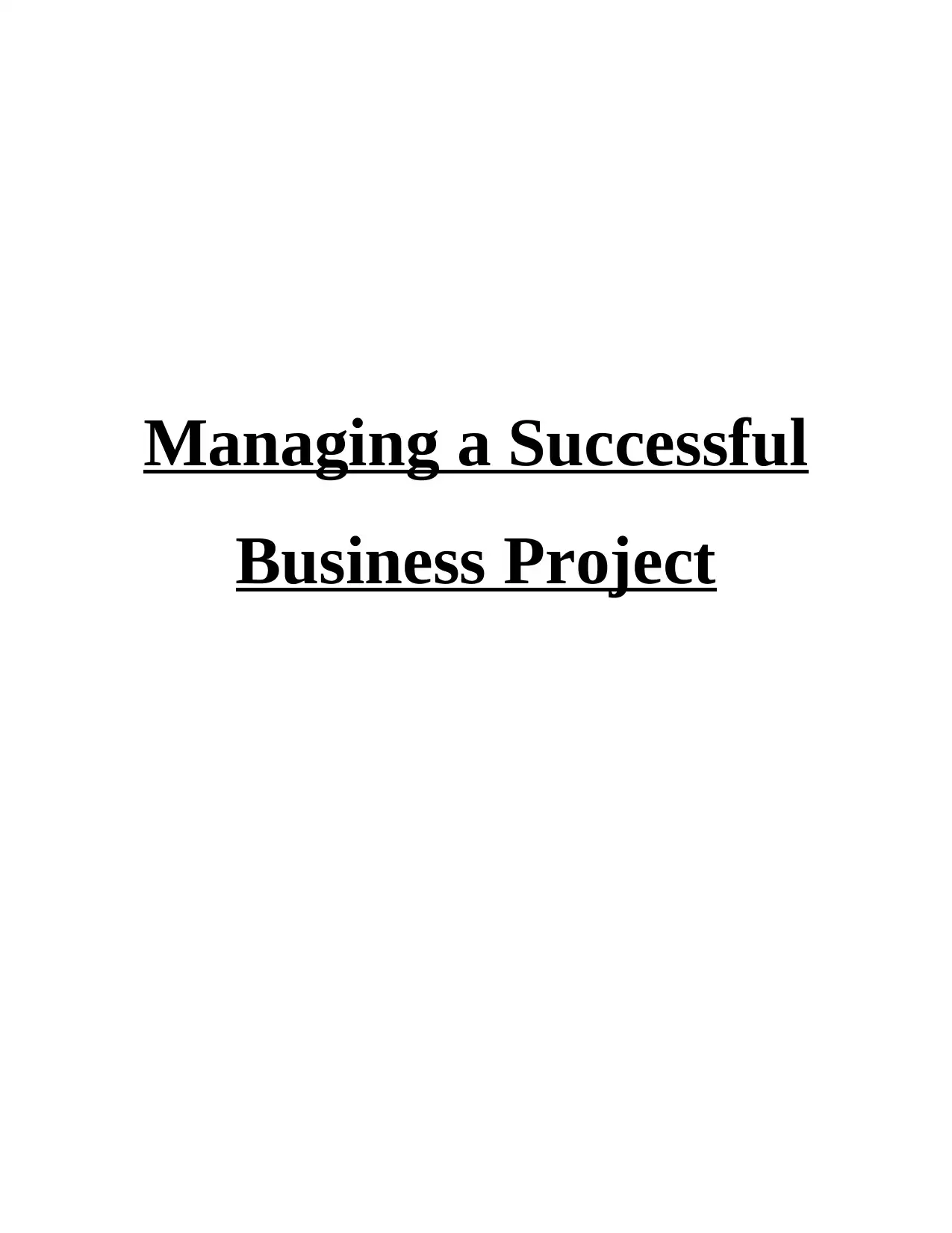
Managing a Successful
Business Project
Business Project
Paraphrase This Document
Need a fresh take? Get an instant paraphrase of this document with our AI Paraphraser
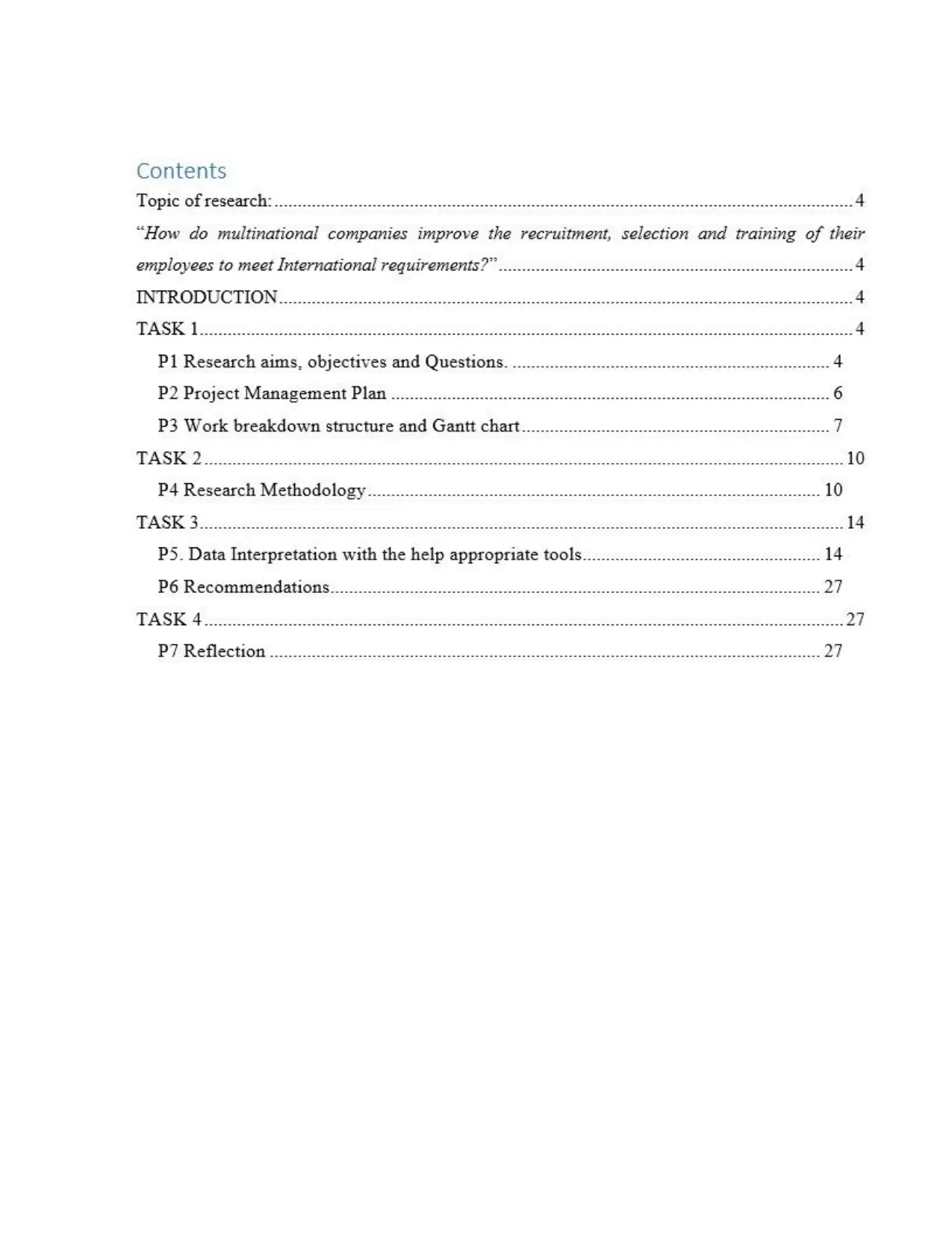

⊘ This is a preview!⊘
Do you want full access?
Subscribe today to unlock all pages.

Trusted by 1+ million students worldwide
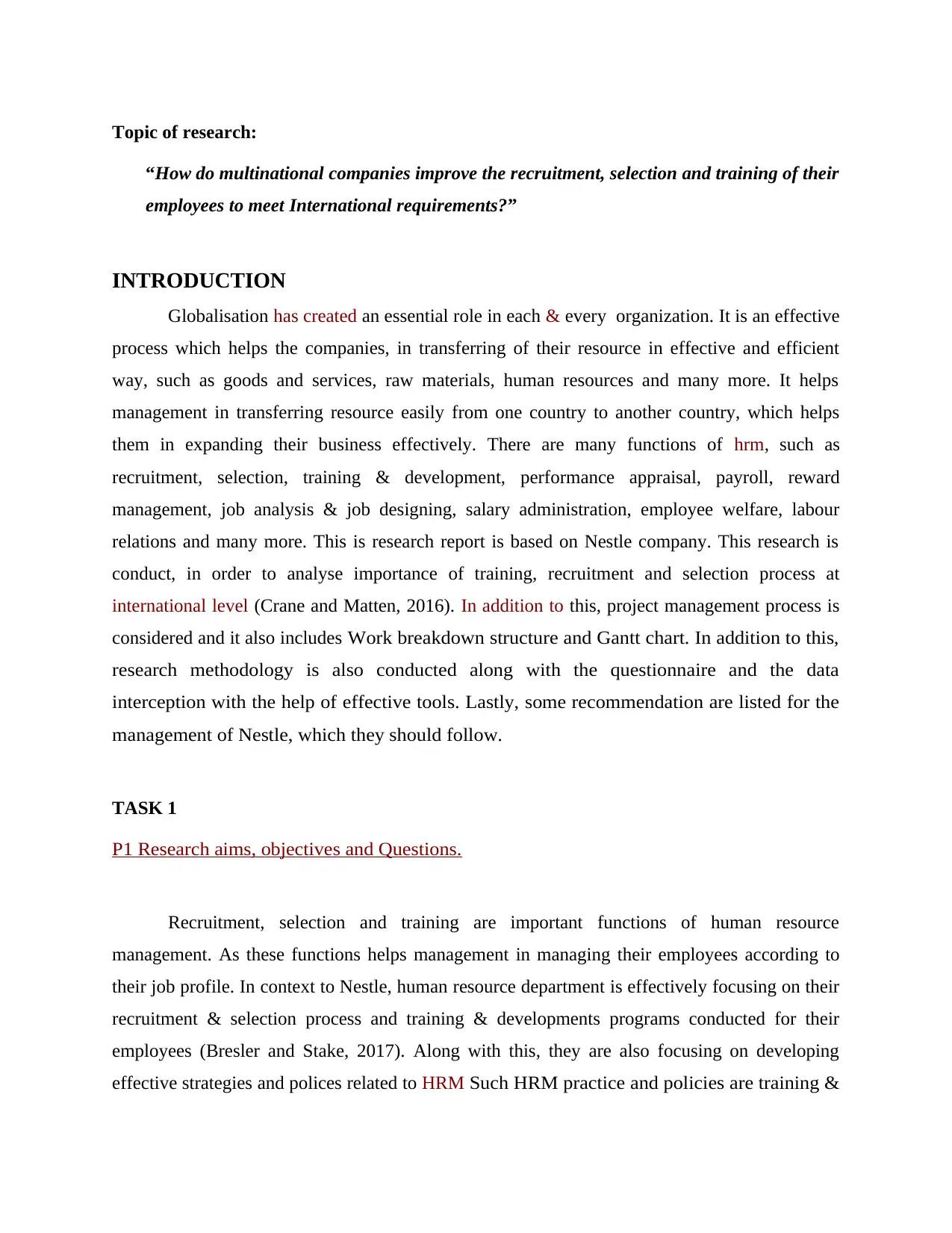
Topic of research:
“How do multinational companies improve the recruitment, selection and training of their
employees to meet International requirements?”
INTRODUCTION
Globalisation has created an essential role in each & every organization. It is an effective
process which helps the companies, in transferring of their resource in effective and efficient
way, such as goods and services, raw materials, human resources and many more. It helps
management in transferring resource easily from one country to another country, which helps
them in expanding their business effectively. There are many functions of hrm, such as
recruitment, selection, training & development, performance appraisal, payroll, reward
management, job analysis & job designing, salary administration, employee welfare, labour
relations and many more. This is research report is based on Nestle company. This research is
conduct, in order to analyse importance of training, recruitment and selection process at
international level (Crane and Matten, 2016). In addition to this, project management process is
considered and it also includes Work breakdown structure and Gantt chart. In addition to this,
research methodology is also conducted along with the questionnaire and the data
interception with the help of effective tools. Lastly, some recommendation are listed for the
management of Nestle, which they should follow.
TASK 1
P1 Research aims, objectives and Questions.
Recruitment, selection and training are important functions of human resource
management. As these functions helps management in managing their employees according to
their job profile. In context to Nestle, human resource department is effectively focusing on their
recruitment & selection process and training & developments programs conducted for their
employees (Bresler and Stake, 2017). Along with this, they are also focusing on developing
effective strategies and polices related to HRM Such HRM practice and policies are training &
“How do multinational companies improve the recruitment, selection and training of their
employees to meet International requirements?”
INTRODUCTION
Globalisation has created an essential role in each & every organization. It is an effective
process which helps the companies, in transferring of their resource in effective and efficient
way, such as goods and services, raw materials, human resources and many more. It helps
management in transferring resource easily from one country to another country, which helps
them in expanding their business effectively. There are many functions of hrm, such as
recruitment, selection, training & development, performance appraisal, payroll, reward
management, job analysis & job designing, salary administration, employee welfare, labour
relations and many more. This is research report is based on Nestle company. This research is
conduct, in order to analyse importance of training, recruitment and selection process at
international level (Crane and Matten, 2016). In addition to this, project management process is
considered and it also includes Work breakdown structure and Gantt chart. In addition to this,
research methodology is also conducted along with the questionnaire and the data
interception with the help of effective tools. Lastly, some recommendation are listed for the
management of Nestle, which they should follow.
TASK 1
P1 Research aims, objectives and Questions.
Recruitment, selection and training are important functions of human resource
management. As these functions helps management in managing their employees according to
their job profile. In context to Nestle, human resource department is effectively focusing on their
recruitment & selection process and training & developments programs conducted for their
employees (Bresler and Stake, 2017). Along with this, they are also focusing on developing
effective strategies and polices related to HRM Such HRM practice and policies are training &
Paraphrase This Document
Need a fresh take? Get an instant paraphrase of this document with our AI Paraphraser
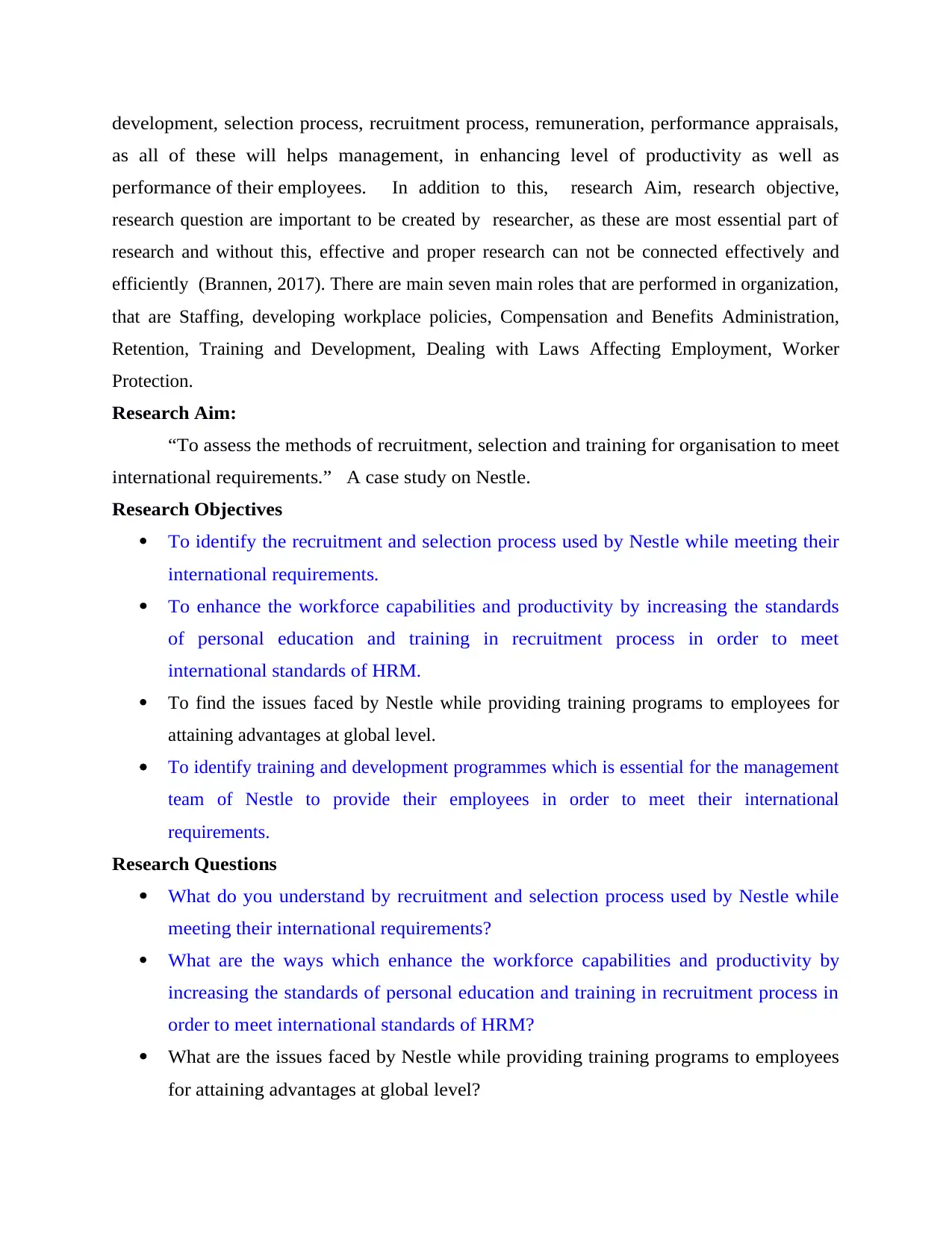
development, selection process, recruitment process, remuneration, performance appraisals,
as all of these will helps management, in enhancing level of productivity as well as
performance of their employees. In addition to this, research Aim, research objective,
research question are important to be created by researcher, as these are most essential part of
research and without this, effective and proper research can not be connected effectively and
efficiently (Brannen, 2017). There are main seven main roles that are performed in organization,
that are Staffing, developing workplace policies, Compensation and Benefits Administration,
Retention, Training and Development, Dealing with Laws Affecting Employment, Worker
Protection.
Research Aim:
“To assess the methods of recruitment, selection and training for organisation to meet
international requirements.” A case study on Nestle.
Research Objectives
To identify the recruitment and selection process used by Nestle while meeting their
international requirements.
To enhance the workforce capabilities and productivity by increasing the standards
of personal education and training in recruitment process in order to meet
international standards of HRM.
To find the issues faced by Nestle while providing training programs to employees for
attaining advantages at global level.
To identify training and development programmes which is essential for the management
team of Nestle to provide their employees in order to meet their international
requirements.
Research Questions
What do you understand by recruitment and selection process used by Nestle while
meeting their international requirements?
What are the ways which enhance the workforce capabilities and productivity by
increasing the standards of personal education and training in recruitment process in
order to meet international standards of HRM?
What are the issues faced by Nestle while providing training programs to employees
for attaining advantages at global level?
as all of these will helps management, in enhancing level of productivity as well as
performance of their employees. In addition to this, research Aim, research objective,
research question are important to be created by researcher, as these are most essential part of
research and without this, effective and proper research can not be connected effectively and
efficiently (Brannen, 2017). There are main seven main roles that are performed in organization,
that are Staffing, developing workplace policies, Compensation and Benefits Administration,
Retention, Training and Development, Dealing with Laws Affecting Employment, Worker
Protection.
Research Aim:
“To assess the methods of recruitment, selection and training for organisation to meet
international requirements.” A case study on Nestle.
Research Objectives
To identify the recruitment and selection process used by Nestle while meeting their
international requirements.
To enhance the workforce capabilities and productivity by increasing the standards
of personal education and training in recruitment process in order to meet
international standards of HRM.
To find the issues faced by Nestle while providing training programs to employees for
attaining advantages at global level.
To identify training and development programmes which is essential for the management
team of Nestle to provide their employees in order to meet their international
requirements.
Research Questions
What do you understand by recruitment and selection process used by Nestle while
meeting their international requirements?
What are the ways which enhance the workforce capabilities and productivity by
increasing the standards of personal education and training in recruitment process in
order to meet international standards of HRM?
What are the issues faced by Nestle while providing training programs to employees
for attaining advantages at global level?
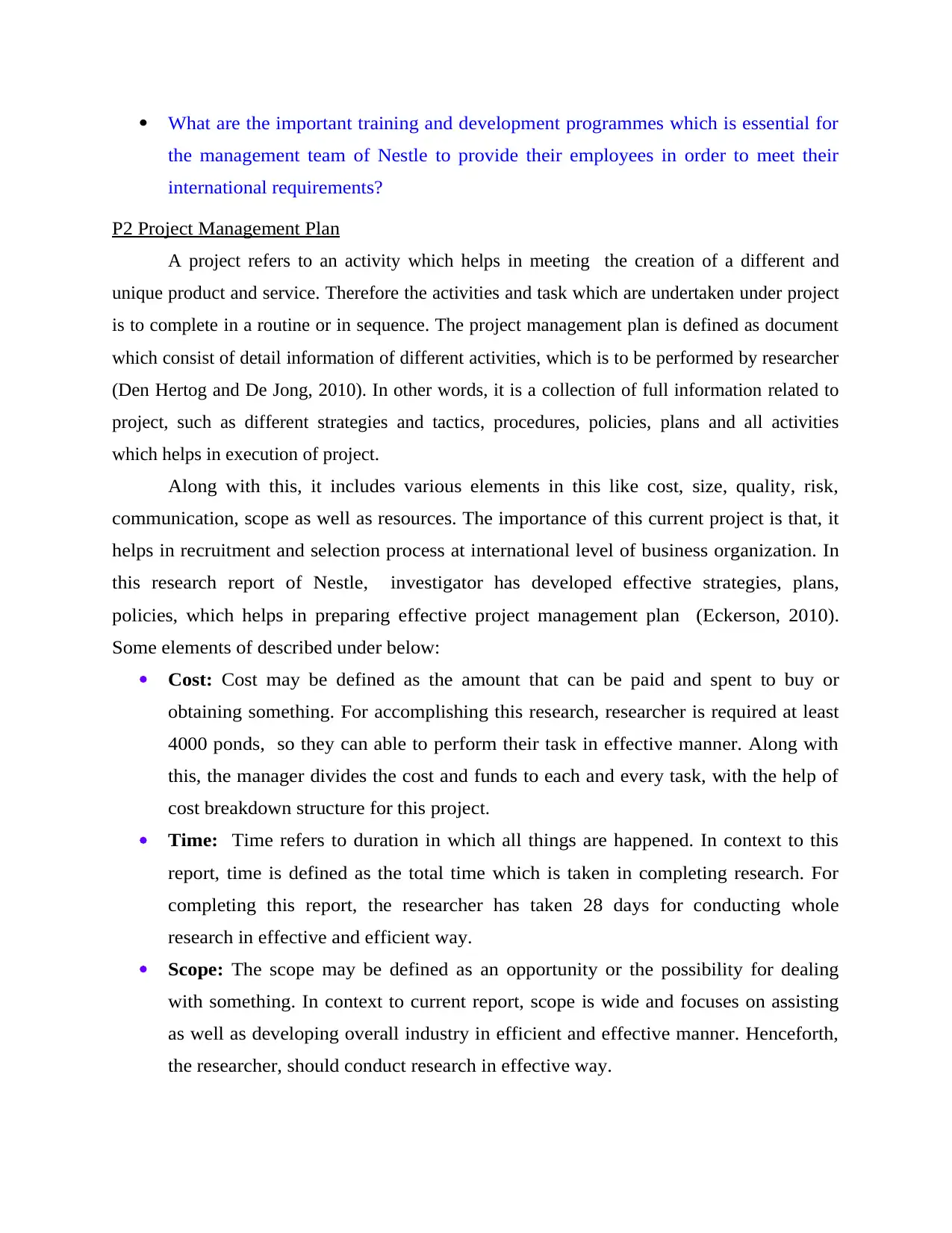
What are the important training and development programmes which is essential for
the management team of Nestle to provide their employees in order to meet their
international requirements?
P2 Project Management Plan
A project refers to an activity which helps in meeting the creation of a different and
unique product and service. Therefore the activities and task which are undertaken under project
is to complete in a routine or in sequence. The project management plan is defined as document
which consist of detail information of different activities, which is to be performed by researcher
(Den Hertog and De Jong, 2010). In other words, it is a collection of full information related to
project, such as different strategies and tactics, procedures, policies, plans and all activities
which helps in execution of project.
Along with this, it includes various elements in this like cost, size, quality, risk,
communication, scope as well as resources. The importance of this current project is that, it
helps in recruitment and selection process at international level of business organization. In
this research report of Nestle, investigator has developed effective strategies, plans,
policies, which helps in preparing effective project management plan (Eckerson, 2010).
Some elements of described under below:
Cost: Cost may be defined as the amount that can be paid and spent to buy or
obtaining something. For accomplishing this research, researcher is required at least
4000 ponds, so they can able to perform their task in effective manner. Along with
this, the manager divides the cost and funds to each and every task, with the help of
cost breakdown structure for this project.
Time: Time refers to duration in which all things are happened. In context to this
report, time is defined as the total time which is taken in completing research. For
completing this report, the researcher has taken 28 days for conducting whole
research in effective and efficient way.
Scope: The scope may be defined as an opportunity or the possibility for dealing
with something. In context to current report, scope is wide and focuses on assisting
as well as developing overall industry in efficient and effective manner. Henceforth,
the researcher, should conduct research in effective way.
the management team of Nestle to provide their employees in order to meet their
international requirements?
P2 Project Management Plan
A project refers to an activity which helps in meeting the creation of a different and
unique product and service. Therefore the activities and task which are undertaken under project
is to complete in a routine or in sequence. The project management plan is defined as document
which consist of detail information of different activities, which is to be performed by researcher
(Den Hertog and De Jong, 2010). In other words, it is a collection of full information related to
project, such as different strategies and tactics, procedures, policies, plans and all activities
which helps in execution of project.
Along with this, it includes various elements in this like cost, size, quality, risk,
communication, scope as well as resources. The importance of this current project is that, it
helps in recruitment and selection process at international level of business organization. In
this research report of Nestle, investigator has developed effective strategies, plans,
policies, which helps in preparing effective project management plan (Eckerson, 2010).
Some elements of described under below:
Cost: Cost may be defined as the amount that can be paid and spent to buy or
obtaining something. For accomplishing this research, researcher is required at least
4000 ponds, so they can able to perform their task in effective manner. Along with
this, the manager divides the cost and funds to each and every task, with the help of
cost breakdown structure for this project.
Time: Time refers to duration in which all things are happened. In context to this
report, time is defined as the total time which is taken in completing research. For
completing this report, the researcher has taken 28 days for conducting whole
research in effective and efficient way.
Scope: The scope may be defined as an opportunity or the possibility for dealing
with something. In context to current report, scope is wide and focuses on assisting
as well as developing overall industry in efficient and effective manner. Henceforth,
the researcher, should conduct research in effective way.
⊘ This is a preview!⊘
Do you want full access?
Subscribe today to unlock all pages.

Trusted by 1+ million students worldwide
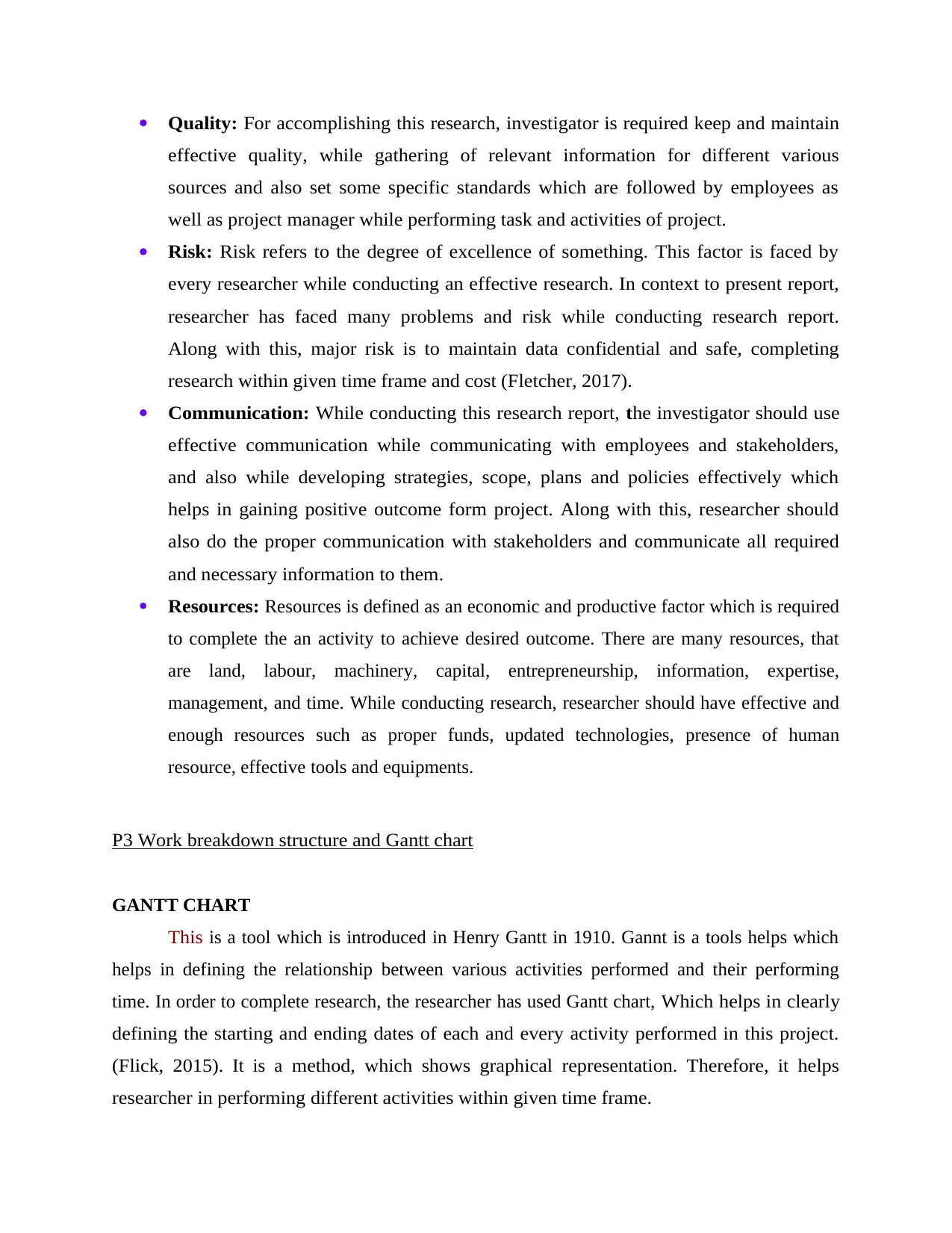
Quality: For accomplishing this research, investigator is required keep and maintain
effective quality, while gathering of relevant information for different various
sources and also set some specific standards which are followed by employees as
well as project manager while performing task and activities of project.
Risk: Risk refers to the degree of excellence of something. This factor is faced by
every researcher while conducting an effective research. In context to present report,
researcher has faced many problems and risk while conducting research report.
Along with this, major risk is to maintain data confidential and safe, completing
research within given time frame and cost (Fletcher, 2017).
Communication: While conducting this research report, the investigator should use
effective communication while communicating with employees and stakeholders,
and also while developing strategies, scope, plans and policies effectively which
helps in gaining positive outcome form project. Along with this, researcher should
also do the proper communication with stakeholders and communicate all required
and necessary information to them.
Resources: Resources is defined as an economic and productive factor which is required
to complete the an activity to achieve desired outcome. There are many resources, that
are land, labour, machinery, capital, entrepreneurship, information, expertise,
management, and time. While conducting research, researcher should have effective and
enough resources such as proper funds, updated technologies, presence of human
resource, effective tools and equipments.
P3 Work breakdown structure and Gantt chart
GANTT CHART
This is a tool which is introduced in Henry Gantt in 1910. Gannt is a tools helps which
helps in defining the relationship between various activities performed and their performing
time. In order to complete research, the researcher has used Gantt chart, Which helps in clearly
defining the starting and ending dates of each and every activity performed in this project.
(Flick, 2015). It is a method, which shows graphical representation. Therefore, it helps
researcher in performing different activities within given time frame.
effective quality, while gathering of relevant information for different various
sources and also set some specific standards which are followed by employees as
well as project manager while performing task and activities of project.
Risk: Risk refers to the degree of excellence of something. This factor is faced by
every researcher while conducting an effective research. In context to present report,
researcher has faced many problems and risk while conducting research report.
Along with this, major risk is to maintain data confidential and safe, completing
research within given time frame and cost (Fletcher, 2017).
Communication: While conducting this research report, the investigator should use
effective communication while communicating with employees and stakeholders,
and also while developing strategies, scope, plans and policies effectively which
helps in gaining positive outcome form project. Along with this, researcher should
also do the proper communication with stakeholders and communicate all required
and necessary information to them.
Resources: Resources is defined as an economic and productive factor which is required
to complete the an activity to achieve desired outcome. There are many resources, that
are land, labour, machinery, capital, entrepreneurship, information, expertise,
management, and time. While conducting research, researcher should have effective and
enough resources such as proper funds, updated technologies, presence of human
resource, effective tools and equipments.
P3 Work breakdown structure and Gantt chart
GANTT CHART
This is a tool which is introduced in Henry Gantt in 1910. Gannt is a tools helps which
helps in defining the relationship between various activities performed and their performing
time. In order to complete research, the researcher has used Gantt chart, Which helps in clearly
defining the starting and ending dates of each and every activity performed in this project.
(Flick, 2015). It is a method, which shows graphical representation. Therefore, it helps
researcher in performing different activities within given time frame.
Paraphrase This Document
Need a fresh take? Get an instant paraphrase of this document with our AI Paraphraser
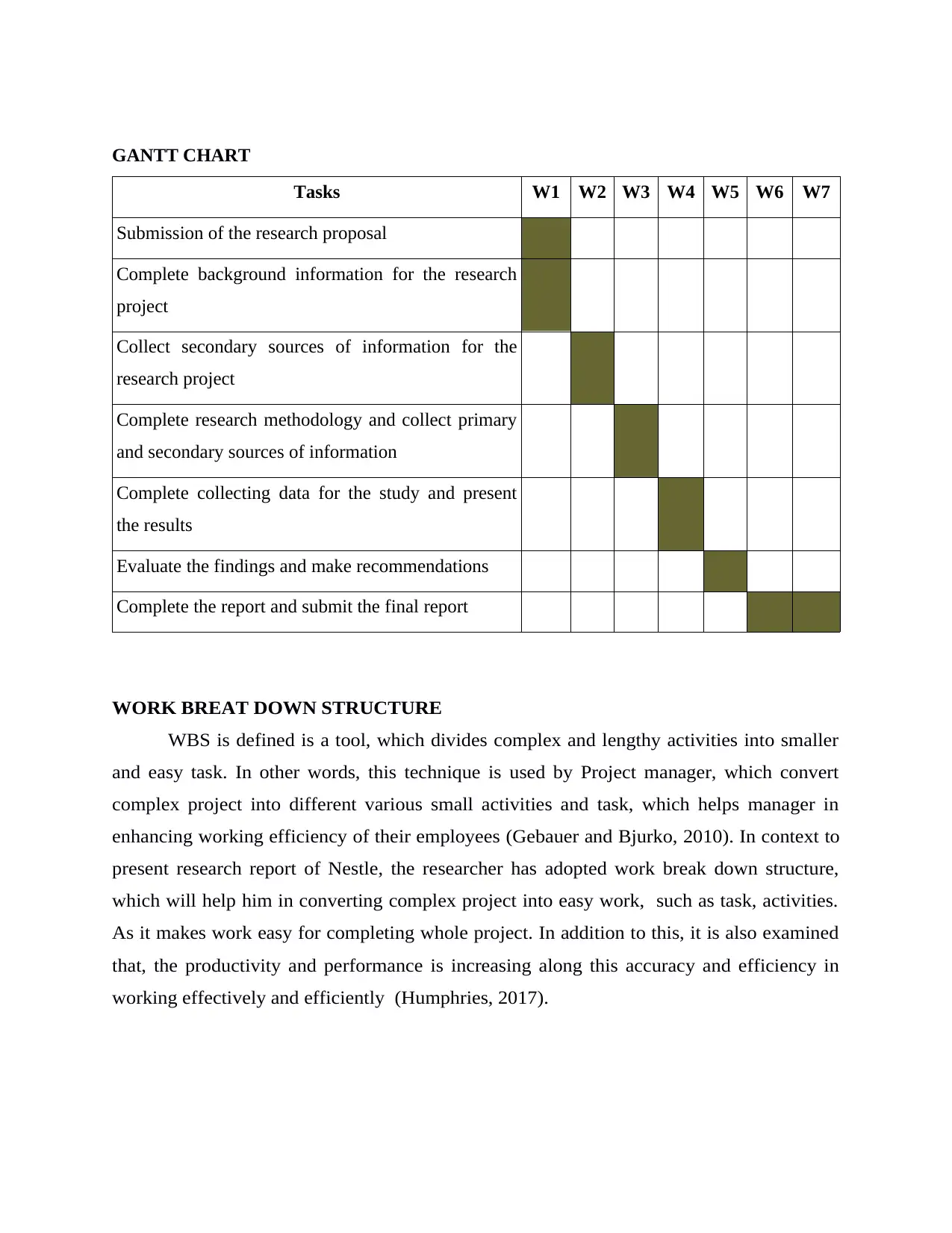
GANTT CHART
Tasks W1 W2 W3 W4 W5 W6 W7
Submission of the research proposal
Complete background information for the research
project
Collect secondary sources of information for the
research project
Complete research methodology and collect primary
and secondary sources of information
Complete collecting data for the study and present
the results
Evaluate the findings and make recommendations
Complete the report and submit the final report
WORK BREAT DOWN STRUCTURE
WBS is defined is a tool, which divides complex and lengthy activities into smaller
and easy task. In other words, this technique is used by Project manager, which convert
complex project into different various small activities and task, which helps manager in
enhancing working efficiency of their employees (Gebauer and Bjurko, 2010). In context to
present research report of Nestle, the researcher has adopted work break down structure,
which will help him in converting complex project into easy work, such as task, activities.
As it makes work easy for completing whole project. In addition to this, it is also examined
that, the productivity and performance is increasing along this accuracy and efficiency in
working effectively and efficiently (Humphries, 2017).
Tasks W1 W2 W3 W4 W5 W6 W7
Submission of the research proposal
Complete background information for the research
project
Collect secondary sources of information for the
research project
Complete research methodology and collect primary
and secondary sources of information
Complete collecting data for the study and present
the results
Evaluate the findings and make recommendations
Complete the report and submit the final report
WORK BREAT DOWN STRUCTURE
WBS is defined is a tool, which divides complex and lengthy activities into smaller
and easy task. In other words, this technique is used by Project manager, which convert
complex project into different various small activities and task, which helps manager in
enhancing working efficiency of their employees (Gebauer and Bjurko, 2010). In context to
present research report of Nestle, the researcher has adopted work break down structure,
which will help him in converting complex project into easy work, such as task, activities.
As it makes work easy for completing whole project. In addition to this, it is also examined
that, the productivity and performance is increasing along this accuracy and efficiency in
working effectively and efficiently (Humphries, 2017).
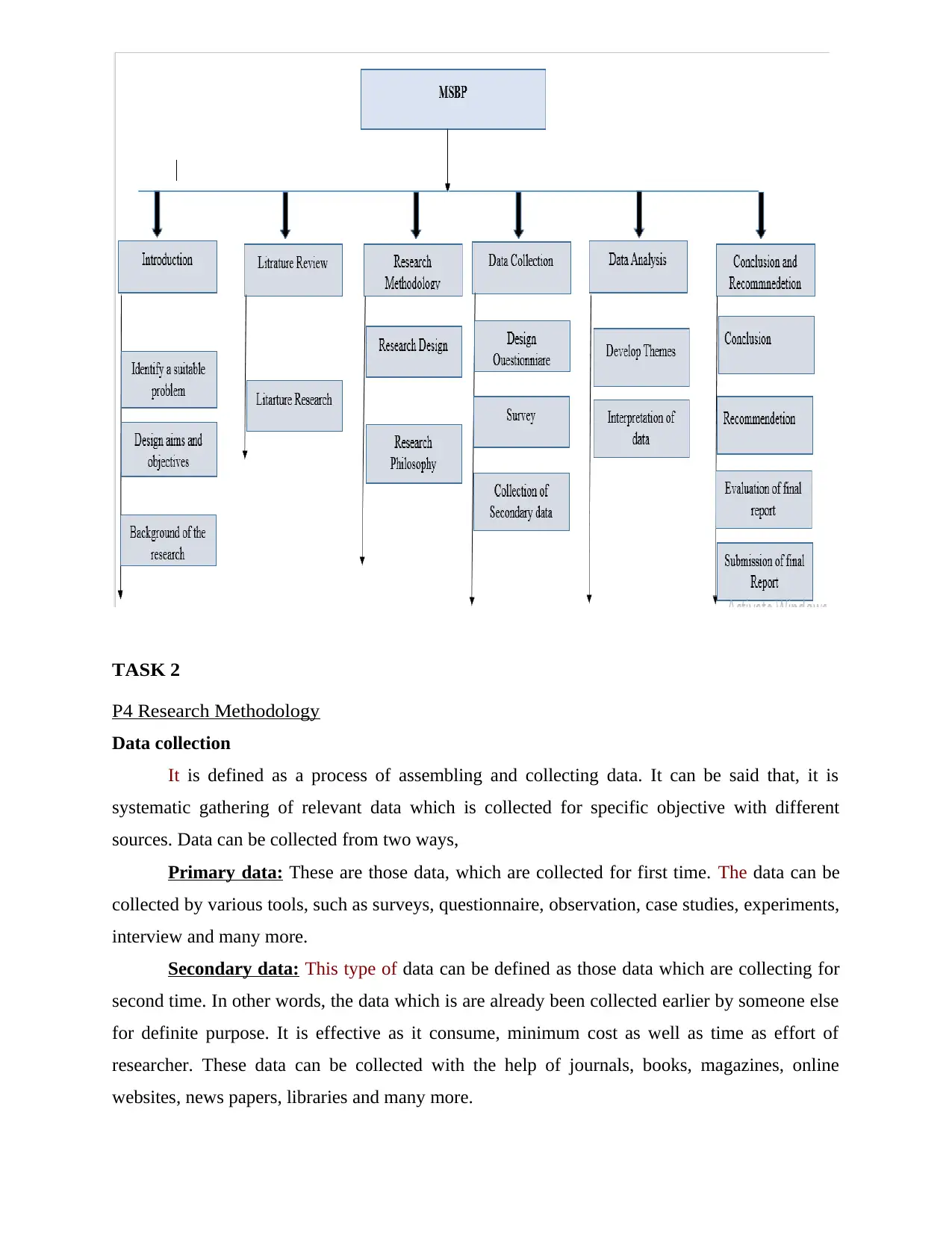
TASK 2
P4 Research Methodology
Data collection
It is defined as a process of assembling and collecting data. It can be said that, it is
systematic gathering of relevant data which is collected for specific objective with different
sources. Data can be collected from two ways,
Primary data: These are those data, which are collected for first time. The data can be
collected by various tools, such as surveys, questionnaire, observation, case studies, experiments,
interview and many more.
Secondary data: This type of data can be defined as those data which are collecting for
second time. In other words, the data which is are already been collected earlier by someone else
for definite purpose. It is effective as it consume, minimum cost as well as time as effort of
researcher. These data can be collected with the help of journals, books, magazines, online
websites, news papers, libraries and many more.
P4 Research Methodology
Data collection
It is defined as a process of assembling and collecting data. It can be said that, it is
systematic gathering of relevant data which is collected for specific objective with different
sources. Data can be collected from two ways,
Primary data: These are those data, which are collected for first time. The data can be
collected by various tools, such as surveys, questionnaire, observation, case studies, experiments,
interview and many more.
Secondary data: This type of data can be defined as those data which are collecting for
second time. In other words, the data which is are already been collected earlier by someone else
for definite purpose. It is effective as it consume, minimum cost as well as time as effort of
researcher. These data can be collected with the help of journals, books, magazines, online
websites, news papers, libraries and many more.
⊘ This is a preview!⊘
Do you want full access?
Subscribe today to unlock all pages.

Trusted by 1+ million students worldwide
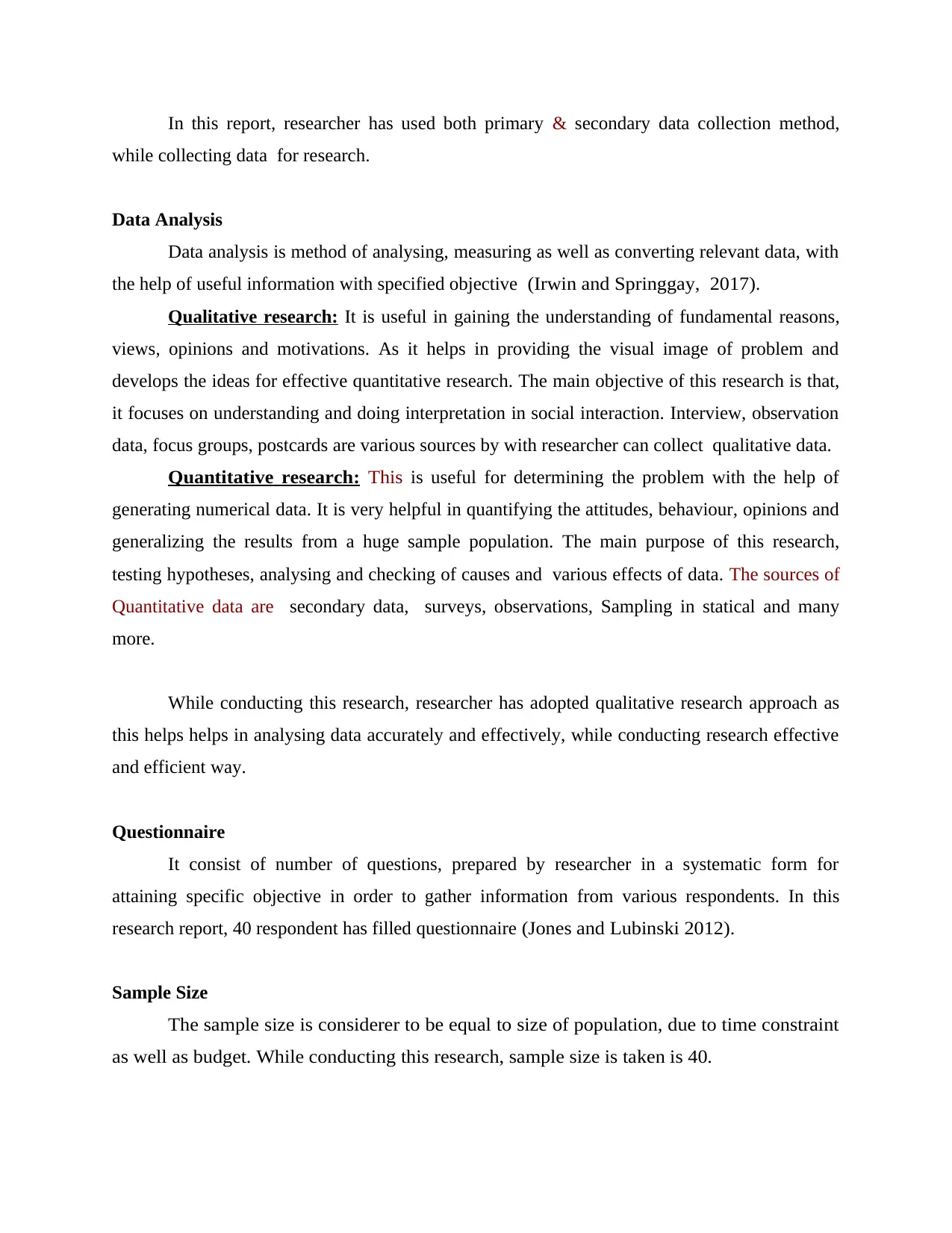
In this report, researcher has used both primary & secondary data collection method,
while collecting data for research.
Data Analysis
Data analysis is method of analysing, measuring as well as converting relevant data, with
the help of useful information with specified objective (Irwin and Springgay, 2017).
Qualitative research: It is useful in gaining the understanding of fundamental reasons,
views, opinions and motivations. As it helps in providing the visual image of problem and
develops the ideas for effective quantitative research. The main objective of this research is that,
it focuses on understanding and doing interpretation in social interaction. Interview, observation
data, focus groups, postcards are various sources by with researcher can collect qualitative data.
Quantitative research: This is useful for determining the problem with the help of
generating numerical data. It is very helpful in quantifying the attitudes, behaviour, opinions and
generalizing the results from a huge sample population. The main purpose of this research,
testing hypotheses, analysing and checking of causes and various effects of data. The sources of
Quantitative data are secondary data, surveys, observations, Sampling in statical and many
more.
While conducting this research, researcher has adopted qualitative research approach as
this helps helps in analysing data accurately and effectively, while conducting research effective
and efficient way.
Questionnaire
It consist of number of questions, prepared by researcher in a systematic form for
attaining specific objective in order to gather information from various respondents. In this
research report, 40 respondent has filled questionnaire (Jones and Lubinski 2012).
Sample Size
The sample size is considerer to be equal to size of population, due to time constraint
as well as budget. While conducting this research, sample size is taken is 40.
while collecting data for research.
Data Analysis
Data analysis is method of analysing, measuring as well as converting relevant data, with
the help of useful information with specified objective (Irwin and Springgay, 2017).
Qualitative research: It is useful in gaining the understanding of fundamental reasons,
views, opinions and motivations. As it helps in providing the visual image of problem and
develops the ideas for effective quantitative research. The main objective of this research is that,
it focuses on understanding and doing interpretation in social interaction. Interview, observation
data, focus groups, postcards are various sources by with researcher can collect qualitative data.
Quantitative research: This is useful for determining the problem with the help of
generating numerical data. It is very helpful in quantifying the attitudes, behaviour, opinions and
generalizing the results from a huge sample population. The main purpose of this research,
testing hypotheses, analysing and checking of causes and various effects of data. The sources of
Quantitative data are secondary data, surveys, observations, Sampling in statical and many
more.
While conducting this research, researcher has adopted qualitative research approach as
this helps helps in analysing data accurately and effectively, while conducting research effective
and efficient way.
Questionnaire
It consist of number of questions, prepared by researcher in a systematic form for
attaining specific objective in order to gather information from various respondents. In this
research report, 40 respondent has filled questionnaire (Jones and Lubinski 2012).
Sample Size
The sample size is considerer to be equal to size of population, due to time constraint
as well as budget. While conducting this research, sample size is taken is 40.
Paraphrase This Document
Need a fresh take? Get an instant paraphrase of this document with our AI Paraphraser
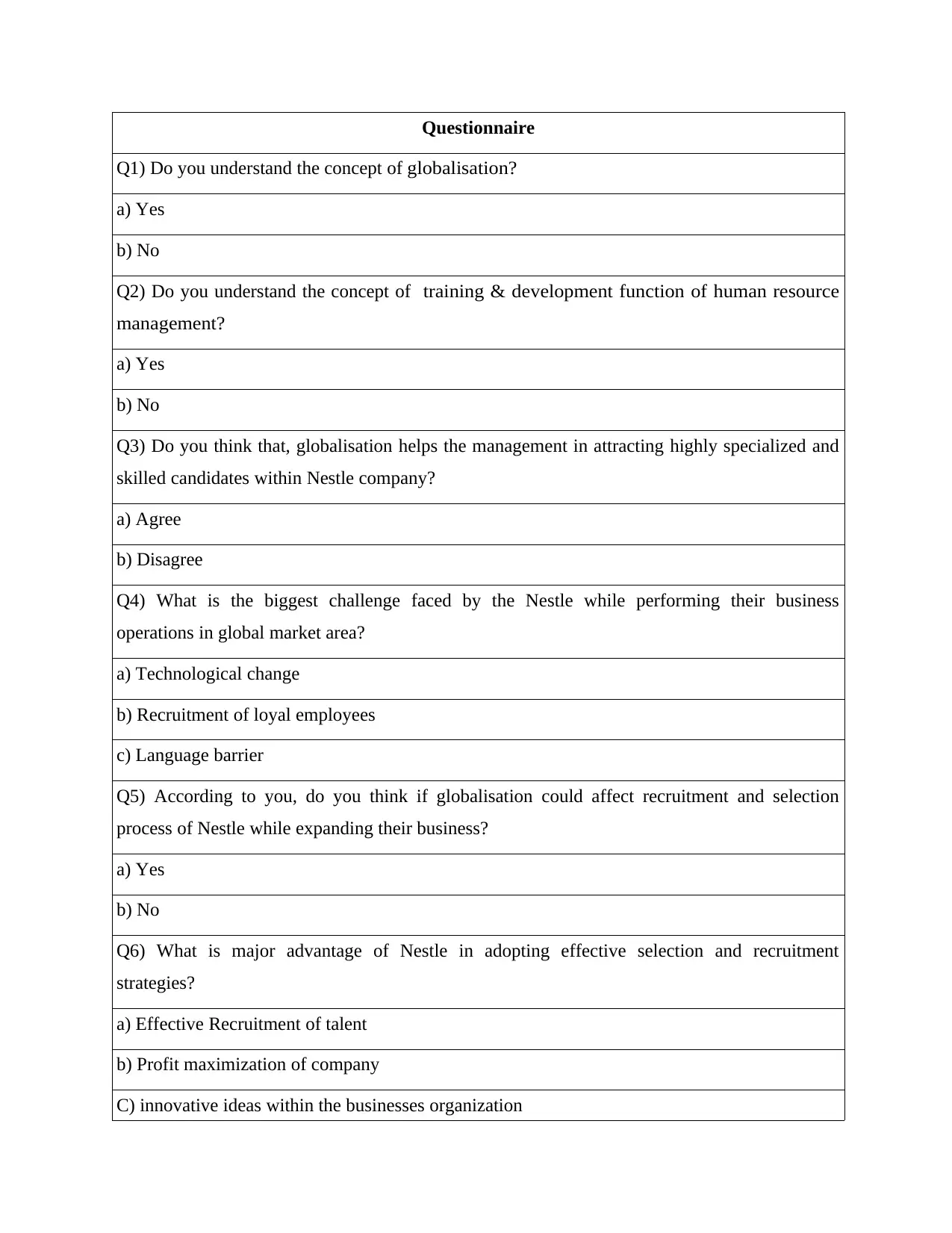
Questionnaire
Q1) Do you understand the concept of globalisation?
a) Yes
b) No
Q2) Do you understand the concept of training & development function of human resource
management?
a) Yes
b) No
Q3) Do you think that, globalisation helps the management in attracting highly specialized and
skilled candidates within Nestle company?
a) Agree
b) Disagree
Q4) What is the biggest challenge faced by the Nestle while performing their business
operations in global market area?
a) Technological change
b) Recruitment of loyal employees
c) Language barrier
Q5) According to you, do you think if globalisation could affect recruitment and selection
process of Nestle while expanding their business?
a) Yes
b) No
Q6) What is major advantage of Nestle in adopting effective selection and recruitment
strategies?
a) Effective Recruitment of talent
b) Profit maximization of company
C) innovative ideas within the businesses organization
Q1) Do you understand the concept of globalisation?
a) Yes
b) No
Q2) Do you understand the concept of training & development function of human resource
management?
a) Yes
b) No
Q3) Do you think that, globalisation helps the management in attracting highly specialized and
skilled candidates within Nestle company?
a) Agree
b) Disagree
Q4) What is the biggest challenge faced by the Nestle while performing their business
operations in global market area?
a) Technological change
b) Recruitment of loyal employees
c) Language barrier
Q5) According to you, do you think if globalisation could affect recruitment and selection
process of Nestle while expanding their business?
a) Yes
b) No
Q6) What is major advantage of Nestle in adopting effective selection and recruitment
strategies?
a) Effective Recruitment of talent
b) Profit maximization of company
C) innovative ideas within the businesses organization
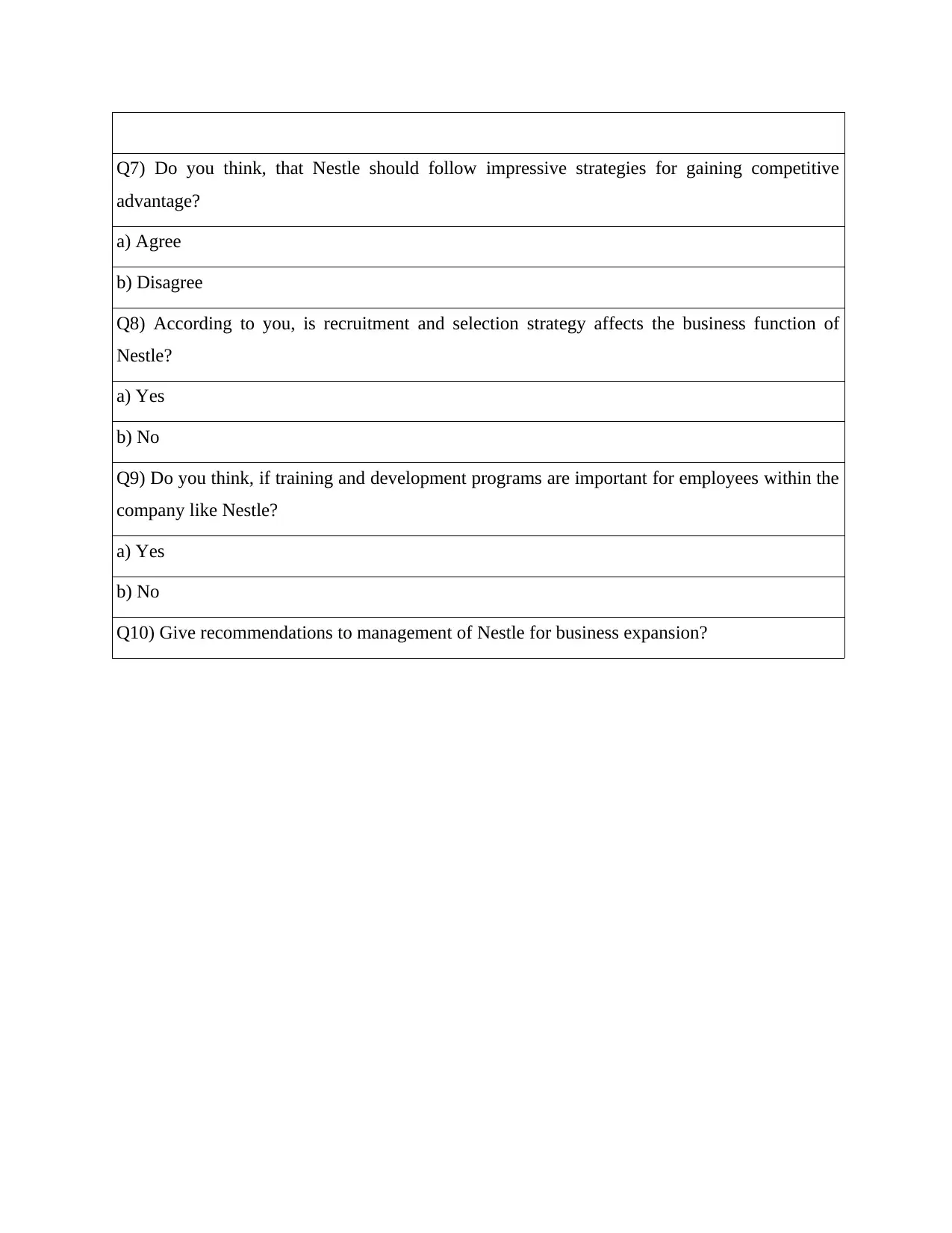
Q7) Do you think, that Nestle should follow impressive strategies for gaining competitive
advantage?
a) Agree
b) Disagree
Q8) According to you, is recruitment and selection strategy affects the business function of
Nestle?
a) Yes
b) No
Q9) Do you think, if training and development programs are important for employees within the
company like Nestle?
a) Yes
b) No
Q10) Give recommendations to management of Nestle for business expansion?
advantage?
a) Agree
b) Disagree
Q8) According to you, is recruitment and selection strategy affects the business function of
Nestle?
a) Yes
b) No
Q9) Do you think, if training and development programs are important for employees within the
company like Nestle?
a) Yes
b) No
Q10) Give recommendations to management of Nestle for business expansion?
⊘ This is a preview!⊘
Do you want full access?
Subscribe today to unlock all pages.

Trusted by 1+ million students worldwide
1 out of 29
Related Documents
Your All-in-One AI-Powered Toolkit for Academic Success.
+13062052269
info@desklib.com
Available 24*7 on WhatsApp / Email
![[object Object]](/_next/static/media/star-bottom.7253800d.svg)
Unlock your academic potential
Copyright © 2020–2025 A2Z Services. All Rights Reserved. Developed and managed by ZUCOL.





